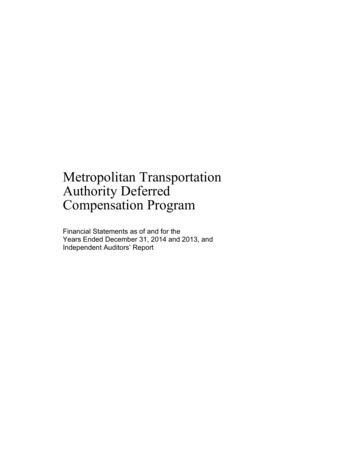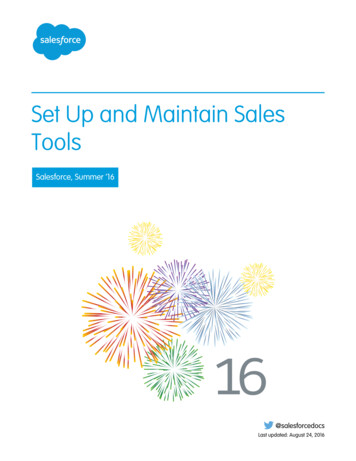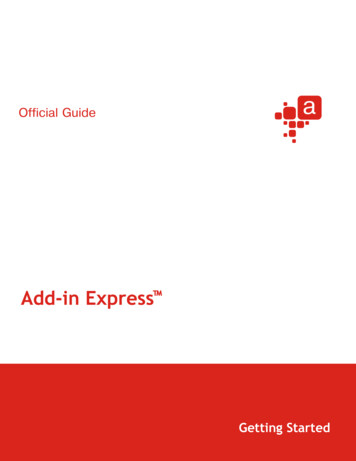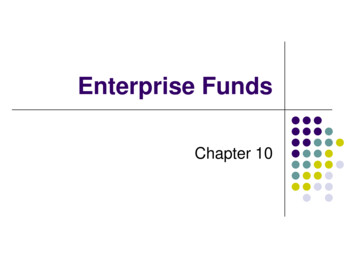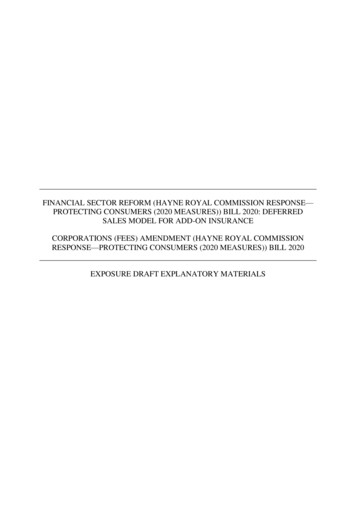
Transcription
FINANCIAL SECTOR REFORM (HAYNE ROYAL COMMISSION RESPONSE—PROTECTING CONSUMERS (2020 MEASURES)) BILL 2020: DEFERREDSALES MODEL FOR ADD-ON INSURANCECORPORATIONS (FEES) AMENDMENT (HAYNE ROYAL COMMISSIONRESPONSE—PROTECTING CONSUMERS (2020 MEASURES)) BILL 2020EXPOSURE DRAFT EXPLANATORY MATERIALS
Table of contentsGlossary. 1Chapter 1Deferred sales model for add-on insurance . 3
GlossaryThe following abbreviations and acronyms are used throughout thisexplanatory memorandum.AbbreviationDefinitionASICAustralian Securities and InvestmentsCommissionASIC Act 2001Australian Securities and InvestmentsCommission Act 2001Financial Services RoyalCommissionRoyal Commission into Misconduct in theBanking, Superannuation and FinancialServices Industry1
Chapter 1Deferred sales model for add-oninsuranceOutline of chapter1.1Schedule [4.3] to this Bill amends the ASIC Act to implementan industry wide deferred sales model for the sale of add-on insuranceproducts. These amendments give effect to recommendation 4.3 of theFinancial Services Royal Commission.1.2All references in this Chapter are to the ASIC Act unlessotherwise stated.Context of amendments1.3Add-on insurance products are insurance products that are soldalongside, or in relation to, the offer or sale of a principal good or service.Examples of add-on insurance products include consumer creditinsurance, travel insurance and mobile phone screen protection insurance.The Financial Services Royal Commission found that: add-on insurance products represent poor value forconsumers; insurers can pay more in commissions than in claims; consumer claim outcomes are considerably worse than inmarkets where there is meaningful competition; and consumers are at risk of unfair sales and adverse outcomes.1.4Previous work by ASIC and the Productivity Commission hasalso highlighted widespread issues in add-on insurance markets. In 2016,ASIC released three reports covering its review of the sale of add-oninsurance through car dealers: Report 470 — Buying add-on insurance in car yards: Why itcan be hard to say no; Report 471 — The sale of life insurance through car dealers:Taking consumers for a ride; and Report 492 — A market that is failing consumers: The sale ofadd-on insurance through car dealers.3
Financial Sector Reform (Hayne Royal Commission Response—Protecting Consumers (2020Measures)) Bill 2020: Deferred sales model for add-on insuranceCorporations (Fees) Amendment (Hayne Royal Commission Response—Protecting Consumers(2020 Measures)) Bill 20201.5The review found that car-yard add-on insurance is expensive, isof poor value and often provides consumers little or no benefit.1.6The Productivity Commission also found weak competition inthe broader add-on insurance market in its inquiry report titledCompetition in the Australian Financial System Report, released in 2018.1.7As a result, the Financial Services Royal Commissionrecommended that: a Treasury-led working group should develop anindustry-wide deferred sales model for the sale of any add-oninsurance products (except policies of comprehensive carinsurance); and the model be implemented as soon as is reasonablypracticable.1.8On 4 February 2019, in its response to the Financial ServicesRoyal Commission, the Government agreed to mandate an industry-widedeferred sales model, tasking Treasury to develop an appropriate model.1.9On 9 September 2019, Treasury released a proposal paper titledReforms to the sale of add-on insurance products. The paper outlined theGovernment’s proposed approach to implementing a deferred sales modeland sought feedback from stakeholders. Treasury received 41 stakeholdersubmissions. These amendments have been developed taking into accountthe views expressed in those submissions.Summary of new law1.10Schedule [4.3] to this Bill implements an industry-wide deferredsales model for the sale of add-on insurance products.1.11Broadly, an add-on insurance product is an insurance productwhich is sold to cover risks associated with the offer or sale of a principalproduct or service either by the provider of the principal product orservice or by a related party.1.12The deferred sales model separates the sale of an add-oninsurance product from that of the principal product or service, andapplies across all sales channels – including in-person and online. Thedeferred sales model prohibits the sale of add-on insurance products for atleast four clear days after a consumer has entered into a commitment toacquire the principal product or service.1.134The deferred sales model does not apply to:
Deferred sales model for add-on insurance products that are the subject of an ASIC product interventionorder which imposes a deferred sales period; comprehensive car insurance; products that the Minister exempts by regulations; products and entities that ASIC exempts by notifiable orlegislative instrument; and products recommended by financial advisers.1.14which:The add-on insurance deferral period is the period of time begins at the later of:– the time the consumer enters into the commitment toacquire the principal product or service to which the addon insurance product relates; or– the time the consumer is given information about theproduct as prescribed by ASIC (the prescribedinformation); and ends four days later.1.15During the add-on insurance deferral period, a series ofprohibitions apply in relation to the sale of the add-on insurance product,and communicating with consumers in relation to the add-on insuranceproduct. These prohibitions apply to both the principal provider andrelated third parties who sell add-on insurance products.1.16In the period after the add-on insurance deferral period, butbefore the date that is six weeks after the beginning of the add-oninsurance deferral period, add-on insurance products may be sold toconsumers. Communication with the consumer in forms other than writingis restricted.1.17Six weeks after the beginning of the add-on insurance deferralperiod, the deferred sales model ends. After that time, any contact madeby the principal provider or a third party with the consumer will be subjectto the anti-hawking obligations.1.18The ‘add-on insurance pre-deferral period’ is the period that: begins when the consumer indicates an intention to acquirethe principal product or service; and if there is an add-on insurance deferral period in relation tothe add-on insurance product, ends immediately before thestart of the deferral period, or otherwise does not end.5
Financial Sector Reform (Hayne Royal Commission Response—Protecting Consumers (2020Measures)) Bill 2020: Deferred sales model for add-on insuranceCorporations (Fees) Amendment (Hayne Royal Commission Response—Protecting Consumers(2020 Measures)) Bill 20201.19During the add-on insurance pre-deferral period, any party cancommunicate with a consumer about the add-on insurance product, but isprohibited from selling the add-on insurance product to the consumer.1.20At any stage during the deferred sales model periods, both theprincipal provider and a third party may respond to consumer inquiries.This recognises instances where the consumer has queries about theproduct or its features after reviewing the prescribed information.1.21At any stage during the deferred sales model periods, aconsumer can inform either the principal provider or a related third partythat they no longer wish to receive offers, requests or invitations topurchase or apply for an add-on insurance product. Once a consumer hasmade such a request, it is an offence for the principal provider or a thirdparty to offer, request or invite a consumer to purchase or apply for anadd-on insurance product.6
Outline of the deferred sales model for add-on insurance7
Deferred sales model for add-on insuranceComparison of key features of new law and current lawNew lawCurrent lawIt is an offence to sell an add-oninsurance product before the end ofthe add-on insurance deferral period.No specific restrictions apply inrelation to selling add-on insuranceproducts.The add-on insurance product may besold to the consumer after the end ofthe add-on insurance deferral period.No specific restrictions apply inrelation to selling add-on insuranceproducts.It is an offence for the principalprovider to offer, request or invite theconsumer to ask for, apply for, orpurchase the add-on insuranceproduct during the the add-oninsurance deferral period, other thanin writing.It is an offence for a third partyprovider to offer, request or invite theconsumer to ask for, apply for, orpurchase the add-on insuranceproduct during the the add-oninsurance deferral period, other thanin writing.No specific restrictions apply inrelation to offering to sell add-oninsurance products.It is an offence for the principalprovider to offer, request or invite theconsumer to ask for, apply for, orpurchase the add-on insuranceproduct between the end of theadd-on insurance deferral period andsix weeks after the beginning of theadd-on insurance deferral period,other than in writing.It is an offence for a third partyprovider to offer, request or invite theconsumer to ask for, apply for, orpurchase the add-on insuranceproduct between the end of theadd-on insurance deferral period andsix weeks after the beginning of theadd-on insurance deferral period,other than in writing.No specific restrictions apply inrelation to offering to sell add-oninsurance products.9
Financial Sector Reform (Hayne Royal Commission Response—Protecting Consumers (2020Measures)) Bill 2020: Deferred sales model for add-on insuranceCorporations (Fees) Amendment (Hayne Royal Commission Response—Protecting Consumers(2020 Measures)) Bill 2020New law10Current lawIf either the principal provider or athird party provider is contacted bythe consumer during the add-oninsurance deferral period, either partymay respond to the consumer’sinquiry using any method ofcommunication, as long as theresponse relates only to the purposefor which the consumer initiated thecontact.Parties selling add-on insuranceproducts may respond to consumerinquiries at any stage using anymethod of communication.If either the principal provider or athird party provider is contacted bythe consumer after the end of the addon insurance deferral period butbefore six weeks after the beginningof the add-on insurance deferralperiod, either party may respond tothe consumer’s inquiry using anymethod of communication.Parties selling add-on insuranceproducts may respond to consumerinquiries at any stage using anymethod of communication.The principal provider commits anoffence if they offer, request or invitethe consumer to purchase or apply forthe add-on insurance product after theconsumer informs them that they nolonger want to receive offers, requestsor invitations to apply for or purchasethe add-on insurance product.A third party provider commits anoffence if they offer, request or invitethe consumer to purchase or apply forthe add-on insurance product after theconsumer informs the principalprovider that they do not want toreceive offers, requests or invitationsto apply for or purchase the add-oninsurance product.Parties selling add-on insuranceproducts may offer to sell add-oninsurance products, as long as theoffer is not a breach of the antihawking obligations.
Deferred sales model for add-on insuranceDetailed explanation of new lawWhat is an add-on insurance product?1.22The deferred sales model applies to add-on insurance products.An add-on insurance product is a financial product that: is offered or sold to a consumer in connection with theconsumer entering into a commitment to acquire a product orservice; is offered or sold by the person who sold the principalproduct or service or by a third party with an arrangementwith the person who sold the principal product or servicewhich covers the add-on insurance product; manages financial risk related to the principal product orservice; and is either a contract of insurance or a benefit under a contractof insurance.[Schedule [4.3], items 1 and 3, the definition of “add-on insurance product” insubsection 12BA(1) and subsection 12DO(1)]1.23Insurance that is offered by a third party as a result of a referralby a principal provider to the third party will be considered add-oninsurance, assuming the insurance covers risks associated with theprincipal product or service.1.24Add-on insurance may also be provided to consumers undergroup arrangements where the consumer stands to benefit from aninsurance contract between the add-on product provider and an insurer,assuming the insurance covers risks associated with the principal productor service.1.25An insurance product offered on the standalone market is not anadd-on insurance product or service.Example 1.1 – what is an add-on insurance productBen visits a pet shop and purchases a chihuahua. Immediatelyafterwards, Ben purchases an insurance policy that covers thechihuahua for certain types of veterinary treatments in the future. Theinsurance policy is provided by a third party provider that has anarrangement with the pet shop owner.This is an add-on insurance product because it is a contract ofinsurance which is sold in connection to a consumer obtaining aprincipal product (the chihuahua), which manages risks associated withthat product, and which is sold by the principal provider or third partywith an arrangement to sell.11
Financial Sector Reform (Hayne Royal Commission Response—Protecting Consumers (2020Measures)) Bill 2020: Deferred sales model for add-on insuranceCorporations (Fees) Amendment (Hayne Royal Commission Response—Protecting Consumers(2020 Measures)) Bill 2020Example 1.2 – what is an add-on insurance productWendy arranges a mortgage with a bank. The bank asks Wendy if shewould like to purchase mortgage protection insurance, to which Wendyagrees. The bank has an arrangement with a third party insurer andprovides them with Wendy’s details. One week later, the insurer callsWendy to offer mortgage protection insurance.The insurance offered is add-on insurance because it is offered by athird party provider under an arrangement with the principal providerto sell add-on insurance.– what is not an add-on insurance productNicki purchases a house at 1 Smith Street. Several months later, shepurchases a home contents insurance policy on the standalone marketfor 1 Smith Street.This policy is not an add-on insurance product, as it was not sold toNicki in connection with Nicki entering into a commitment to obtainthe principal product (the house).1.26A contract of insurance includes: a contract that would ordinarily be regarded as a contract ofinsurance even if some of its provisions are not by way ofinsurance; and a contract that includes provisions of insurance in so far asthose provisions are concerned, even if the contract wouldnot ordinarily be regarded as a contract of insurance.[Schedule [4.3], item 3, subsection 12DO(2)]Interaction with the anti-hawking obligations1.27Unsolicited offers for the sale of financial products are generallyprohibited by the anti-hawking obligations (section 992A of theCorporations Act 2001).1.28For add-on insurance products, the deferred sales model willreplace the anti-hawking obligations. Broadly, this means that providersof insurance will be subject to either the deferred sales model or theanti-hawking obligations, but not both at the same time. In circumstanceswhere there are no requirements under the deferred sales model, or anexemption from the deferred sales model applies, the anti-hawkingobligations will apply.1.29As outlined in the exposure draft for the anti-hawkingprovisions, the hawking prohibitions apply to offers, requests or12
Deferred sales model for add-on insuranceinvitations to apply for add-on insurance products if they are made sixweeks after either: the day the add-on insurance deferral period begins; or if there is no add-on insurance deferral period, the day onwhich the consumer indicates an intention to purchase aprincipal product to which an add-on insurance productrelates.1.30The hawking prohibitions will also apply to offers, requests orinvitations to apply for add-on insurance products if the consumerpreviously stated they did not wish to receive such offers, requests orinvitations.The add-on insurance pre-deferral period1.31The ‘add-on insurance pre-deferral period’ is the period that: begins when the consumer indicates an intention to acquirethe principal product or service; and if there is an add-on insurance deferral period in relation tothe add-on insurance product, ends immediately before thestart of the deferral period, or otherwise does not end.[Schedule [4.3], items 1 and 3, the definition of “add-on insurance pre-deferral period”in subsection 12BA(1) and subsection 12DP(3)]1.32The purpose of the add-on insurance pre-deferral period is toenable the unsolicited offer of add-on insurance to consumers withouttriggering the anti-hawking obligations.1.33During the add-on insurance pre-deferral period, the principalprovider or a third party provider may not sell add-on insurance productsto consumers. [Schedule [4.3], item 3, section 12DQ]1.34Whether a consumer has indicated an intention to acquire aprincipal product or service will depend on the circumstances. Aconsumer will generally indicate an intention to acquire a product orservice by making a statement that they are considering purchasing aproduct or service or asking questions about a product or service of arepresentative of a business that sells that product or service.The add-on insurance deferral period1.35The add-on insurance deferral period begins at the later of: the time when the consumer enters into a commitment toacquire, or acquires, the principal product or service to whichthe add-on insurance product relates; or13
Financial Sector Reform (Hayne Royal Commission Response—Protecting Consumers (2020Measures)) Bill 2020: Deferred sales model for add-on insuranceCorporations (Fees) Amendment (Hayne Royal Commission Response—Protecting Consumers(2020 Measures)) Bill 2020 the time when the consumer is given the informationprescribed by ASIC relating to the add-on insurance product.[Schedule [4.3], items 1 and 3, the definition of “add-on insurance deferral period” insubsection 12BA(1) and subsection 12DP(2)]1.36The add-on insurance deferral period ends four days after theday it begins. The four day deferral period provides the consumer anopportunity to consider the suitability of the add-on insurance productbeing offered and alternative products, while reducing the likelihood ofthe consumer disengaging entirely from the decision about whether topurchase the add-on insurance product. [Schedule [4.3], item 3, subsection12DP(2)]– the add-on insurance deferral periodCaroline purchases a new mobile phone and is given prescribedinformation relating to screen protection insurance for the mobilephone on Sunday, 1 January. The deferral period for the insuranceproduct offered to Caroline ends on Thursday, 5 January. Allprohibitions during the deferral period cease to apply from midnight onFriday, 6 January.1.37The add-on insurance deferral period separates the consumer’sdecision to acquire add-on insurance from the decision to acquire theprincipal product or service. This is to enable the consumer to consider themerits of add-on insurance independently of the principal product orservice and to reduce the likelihood that their decision to acquire add-oninsurance is unduly influenced by pressure from the principal provider orrelated third party.1.38Whether a consumer has entered into a ‘commitment’ to acquirethe principal product or service will depend on the circumstances. Acommitment is generally a firm decision by the consumer to acquire theprincipal product or service, such as making a payment or entering into acontractual agreement to pay at a later date. A consumer expressing apreference for a principal product or service does not amount to acommitment.– a commitment to acquire the principal productNik is interested in purchasing a season ticket to the theatre. Before theseason program is released, Nik pays a 50 per cent deposit for theseason ticket online. The deposit would be considered a commitmentto acquire the principal product or service.– not a commitment to acquire the principal productMaddie is in an electronics store looking at mobile phones. She has adiscussion with the salesperson and states a clear preference for a14
Deferred sales model for add-on insuranceparticular handset. Maddie tells the salesperson that she intends toreturn to the store in a week’s time to purchase the phone. Maddie’sstated intention to return to purchase the phone does not represent acommitment to acquire the phone.1.39The regulations may specify when a consumer is taken to haveentered into a commitment to acquire a principal product or service. Theregulation making power is required due to the diversity of add-oninsurance products available in the market and the need to ensure theregime achieves the intended policy outcome for classes of add-oninsurance products. [Schedule [4.3], item 3, subsection 12DO(3)]1.40ASIC can, by legislative instrument, prescribe that certaininformation may be given to a consumer in relation to an add-on insuranceproduct, and the manner in which the information is to be given, for theadd-on insurance deferral period to begin. [Schedule [4.3], item 2,subsection 12DP(4)]1.41The add-on insurance deferral period does not begin if thisinformation has not been given to the consumer. [Schedule [4.3], item 3,subsection 12DP(1)]1.42The information ASIC prescribes must include information thatthe consumer may inform the principal provider or a third party providerthat the consumer does not want to receive any further offers, requests orinvitations for add-on insurance products. This gives the consumer theability to opt-out of further contact relating to the add-on insuranceproduct, if, for example, the consumer has purchased add-on insurance onthe standalone market or decided they did not require add-on insurance.[Schedule [4.3], item 3, subsection 12DP(5)]Prohibitions on the principal provider1.43The prohibitions under the deferred sales model may apply if aconsumer acquires, or enters into a commitment to acquire, a product orservice from a person, and that person offers or sells an add-on insuranceproduct to the consumer in certain circumstances.1.44In certain circumstances, it is both a criminal and civil offence tosell or offer an add-on insurance product to a consumer before the end ofthe add-on insurance deferral period.Prohibitions on selling add-on insurance products1.45The principal provider of the product or service commits anoffence if they sell an add-on insurance product to a consumer, exceptafter the end of the add-on insurance deferral period. [Schedule [4.3], item 3,subsections 12DQ(1) and (3)]1.46The principal provider also commits an offence if:15
Financial Sector Reform (Hayne Royal Commission Response—Protecting Consumers (2020Measures)) Bill 2020: Deferred sales model for add-on insuranceCorporations (Fees) Amendment (Hayne Royal Commission Response—Protecting Consumers(2020 Measures)) Bill 2020 there is an arrangement between the principal provider and athird party provider that relates to the provision of add-oninsurance products in relation to products or services offeredby the principal provider to a consumer; and the third party provider sells an add-on insurance product tothe consumer, except after the end of the add-on insurancedeferral period.[Schedule [4.3], item 3, subsections 12DQ(2) and (3)]Prohibitions on offering add-on insurance products1.47The principal provider commits an offence if they offer anadd-on insurance product for issue or sale to the consumer, or request orinvite the consumer to ask for, apply for, or purchase an add-on insuranceproduct, where the offer, request or invitation is not in writing, except: during the add-on insurance pre-deferral period; or after the end of the add-on insurance deferral period.[Schedule [4.3], item 3, subsections 12DR(1) and (2)]1.48The principal provider commits an offence if they offer anadd-on insurance product for issue or sale to the consumer, or request orinvite the consumer to ask for, apply for, or purchase an add-on insuranceproduct, where the offer, request or invitation is not in writing, except ifthe offer or request is: during the add-on insurance pre-deferral period; or after the end of the period of six weeks beginning on the firstday of the add-on insurance deferral period.[Schedule [4.3], item 3, subsections 12DS(1) and (2)]1.49However, the offences for principal providers in relation tooffering add-on insurance products to consumers do not arise if the offer,request or invitation is made in response to contact initiated by theconsumer (see the section below titled ‘Responding to consumer initiatedcontact’). [Schedule [4.3], item 3, subsections 12DR(4) and 12DS(4)]1.50The principal provider commits an offence if they offer anadd-on insurance product for issue or sale to the consumer, or request orinvite the consumer to ask for, apply for, or purchase an add-on insuranceproduct, where, before the offer, request or invitation is made, theconsumer informs the principal provider that they do not want to receivesuch offers, requests or invitations (see the section below titled ‘Consumerrequests for no further contact’). [Schedule [4.3], item 3, subsection 12DT(1)]16
Deferred sales model for add-on insurance1.51The principal provider commits an offence if they offer anadd-on insurance product for issue or sale to the consumer, or request orinvite the consumer to ask for, apply for, or purchase an add-on insuranceproduct, where before the offer, request or invitation is made, theconsumer informs any person with whom the principal provider has anarrangement which covers the add-on insurance product that they do notwant to receive such offers, requests or invitations and the principleprovider is reckless as to that fact. [Schedule [4.3], items 3 and 10,subsection 12DT(2) and paragraph 12GBCN(3A)(d)]1.52Recklessness is the fault element that applies to the physicalelement relating to a consumer informing of an opt-out. The fault elementof recklessness is appropriate in this situation as the principal providermay not be privy to circumstances in which the consumer opts-out. Thefault element of recklessness also needs to be established for this physicalelement in civil penalty proceedings. [Schedule [4.3], item 10,paragraph 12GBCN(3A)(d)]1.53A person is reckless to a fact if the person is aware of asubstantial risk that the fact exists and, having regard to the circumstancesknown to the person, it is unjustifiable to take the risk. [Schedule [4.3],item 10, subsection 12GBCN(3B)]Prohibitions on third party providers1.54The prohibitions may also apply to a third party provider if thereis an arrangement between the principal provider and the third partyprovider that relates to the provision of add-on insurance products incertain circumstances.1.55Broadly, the same restrictions apply to the third party providersas the principal provider, except that certain physical elements have thefault element of recklessness for the civil offence.1.56It is appropriate that the fault element of recklessness applies tothese physical elements because a third party provider tends to beremoved from the selling of the principal product or service. A third partyprovider may not be privy to whether the insurance they offer falls withinthe definition of add-on insurance and the extent to which prohibitionsrelating to the offer and sale of add-on insurance should apply. Broadly, athird party provider commits a civil offence only if they are reckless as tothese facts.Prohibitions on selling add-on insurance products1.57The third party provider commits an offence if they sell anadd-on insurance product to the consumer where either of the followingapplies and the third party provider is reckless as to whether it applies: there is no add-on insurance deferral period; or17
Financial Sector Reform (Hayne Royal Commission Response—Protecting Consumers (2020Measures)) Bill 2020: Deferred sales model for add-on insuranceCorporations (Fees) Amendment (Hayne Royal Commission Response—Protecting Consumers(2020 Measures)) Bill 2020 the third party provider sells the add-on insurance product tothe consumer before the end of the add-on insurance deferralperiod.[Schedule [4.3], items 3 and 10, subsection 12DQ(4) and paragraph 12GBCN(3A)(a)]– third party selling add-on insurance during the add-oninsurance deferral periodRoger purchases a dog from Pets4you. The salesperson emails Roger’scontact details to a third party insurer with whom the store has anarrangement to sell pet insurance. The arrangement between the petstore and insurer is well established and includes the process for theinsurer to sell add-on insurance in compliance with the deferred salesmodel. The arrangement is well understood by the insurer.The insurer receives Roger’s details and proceeds to offer petinsurance during the add-on insurance deferral period. Roger buys thepet insurance during the deferral period.The insurer has committed an offence by selling the pet insurancebefore the end of the add-on insurance deferral period.Prohibitions on offering add-on insurance products1.58The third party provider commits an offence if they offer an addon insurance product for issue or sale to the consumer, or request or invitethe consumer to ask for, apply for, or purchase an add-on insuranceproduct, where the offer, request or invitation is not in writing, and ismade during the add-on insurance deferral period and the third partyprovider is reckless as to that fact. [Schedule [4.3], items 3
insurance through car dealers: Report 470 — Buying add-on insurance in car yards: Why it can be hard to say no; Report 471 — The sale of life insurance through car dealers: Taking consumers for a ride; and Report 492 — A market that is failing consumers: The sale of add-on insurance through car dealers.


